Candidates can download NCERT Exemplar Class 12 Chemistry Chapter 14 from this page. The exemplar has been provided by the National Council of Educational Research & Training (NCERT) and the candidates can check it from below for free of cost. It contains objective, very short answer type, short answer type, and long answer type questions. Along with it, the answer for each question has also been provided. From the NCERT Exemplar Class 12 Chemistry Chapter 14, candidates can understand the level and type of questions that are asked in the exam.
NCERT Exemplar Class 12 Chemistry Chapter 14 Biomolecules
NCERT Class 12 Chemistry Chapter 14 is for Biomolecules. The type of questions that will be asked from NCERT Class 12 Chemistry Chapter 14 are displayed in the below provided NCERT Exemplar Class 12 Chemistry Chapter 14. With the help of it, candidates can prepare well for the examination.
Also Check: NCERT Solutions for Class 12 Chemistry
Multiple Choice Questions (Type-I)
- Glycogen is a branched chain polymer of α-D-glucose units in which chain is formed by C1—C4 glycosidic linkage whereas branching occurs by the formation of C1-C6 glycosidic linkage. Structure of glycogen is similar to ______.
(i) Amylose
(ii) Amylopectin
(iii) Cellulose
(iv) Glucose - Which of the following polymer is stored in the liver of animals?
(i) Amylose
(ii) Cellulose
(iii) Amylopectin
(iv) Glycogen - Sucrose (cane sugar) is a disaccharide. One molecule of sucrose on hydrolysis gives _________.
(i) 2 molecules of glucose
(ii) 2 molecules of glucose + 1 molecule of fructose
(iii) 1 molecule of glucose + 1 molecule of fructose
(iv) 2 molecules of fructose - Which of the following pairs represents anomers?

- Proteins are found to have two different types of secondary structures viz. α-helix and β-pleated sheet structure. α-helix structure of protein is stabilised by :
(i) Peptide bonds
(ii) van der Waals forces
(iii) Hydrogen bonds
(iv) Dipole-dipole interactions - In disaccharides, if the reducing groups of monosaccharides i.e. aldehydic or ketonic groups are bonded, these are non-reducing sugars. Which of the following disaccharide is a non-reducing sugar?

- Which of the following acids is a vitamin?
(i) Aspartic acid
(ii) Ascorbic acid
(iii) Adipic acid
(iv) Saccharic acid - Dinucleotide is obtained by joining two nucleotides together by phosphodiester linkage. Between which carbon atoms of pentose sugars of nucleotides are these linkages present?
(i) 5′ and 3′
(ii) 1′ and 5′
(iii) 5′ and 5′
(iv) 3′ and 3′ - Nucleic acids are the polymers of ______________.
(i) Nucleosides
(ii) Nucleotides
(iii) Bases
(iv) Sugars - Which of the following statements is not true about glucose?
(i) It is an aldohexose.
(ii) On heating with HI it forms n-hexane.
(iii) It is present in furanose form.
(iv) It does not give 2,4-DNP test. - Each polypeptide in a protein has amino acids linked with each other in a specific sequence. This sequence of amino acids is said to be ____________.
(i) primary structure of proteins.
(ii) secondary structure of proteins.
(iii) tertiary structure of proteins.
(iv) quaternary structure of proteins. - DNA and RNA contain four bases each. Which of the following bases is not present in RNA?
(i) Adenine
(ii) Uracil
(iii) Thymine
(iv) Cytosine - Which of the following B group vitamins can be stored in our body?
(i) Vitamin B1
(ii) Vitamin B2
(iii) Vitamin B6
(iv) Vitamin B12 - Which of the following bases is not present in DNA?
(i) Adenine
(ii) Thymine
(iii) Cytosine
(iv) Uracil - Three cyclic structures of monosaccharides are given below which of these are anomers.
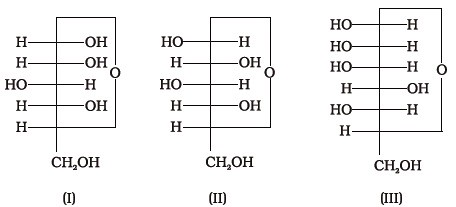
(i) I and II
(ii) II and III
(iii) I and III
(iv) III is anomer of I and II - Which of the following reactions of glucose can be explained only by its cyclic structure?
(i) Glucose forms pentaacetate.
(ii) Glucose reacts with hydroxylamine to form an oxime.
(iii) Pentaacetate of glucose does not react with hydroxylamine.
(iv) Glucose is oxidised by nitric acid to gluconic acid. - Optical rotations of some compounds along with their structures are given below which of them have D configuration.
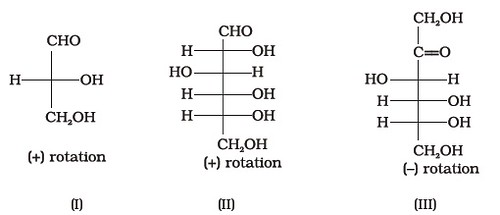
(i) I, II, III
(ii) II, III
(iii) I, II
(iv) III - Structure of a disaccharide formed by glucose and fructose is given below. Identify anomeric carbon atoms in monosaccharide units.
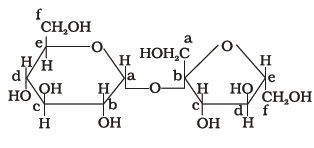
(i) ‘a’ carbon of glucose and ‘a’ carbon of fructose.
(ii) ‘a’ carbon of glucose and ‘e’ carbon of fructose.
(iii) ‘a’ carbon of glucose and ‘b’ carbon of fructose.
(iv) ‘f ’ carbon of glucose and ‘f ’ carbon of fructose. - Three structures are given below in which two glucose units are linked. Which of these linkages between glucose units are between C1 and C4 and which linkages are between C1 and C6?
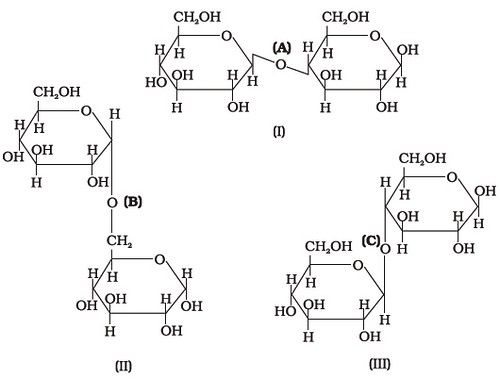
(i) (A) is between C1 and C4, (B) and (C) are between C1 and C6
(ii) (A) and (B) are between C1 and C4, (C) is between C1 and C6
(iii) (A) and (C) are between C1 and C4, (B) is between C1 and C6
(iv) (A) and (C) are between C1 and C6, (B) is between C1 and C4
Multiple Choice Questions (Type-II)
Note : In the following questions two or more options may be correct.
- Carbohydrates are classified on the basis of their behaviour on hydrolysis and also as reducing or non-reducing sugar. Sucrose is a __________.
(i) monosaccharide
(ii) disaccharide
(iii) reducing sugar
(iv) non-reducing sugar - Proteins can be classified into two types on the basis of their molecular shape i.e., fibrous proteins and globular proteins. Examples of globular proteins are :
(i) Insulin
(ii) Keratin
(iii) Albumin
(iv) Myosin - Which of the following carbohydrates are branched polymer of glucose?
(i) Amylose
(ii) Amylopectin
(iii) Cellulose
(iv) Glycogen - Amino acids are classified as acidic, basic or neutral depending upon the relative number of amino and carboxyl groups in their molecule. Which of the following are acidic?

-

(i) α-Amino acid
(ii) Basic amino acid
(iii) Amino acid synthesised in body
(iv) β-Amino acid - Which of the following monosaccharides are present as five membered cyclic structure (furanose structure)?
(i) Ribose
(ii) Glucose
(iii) Fructose
(iv) Galactose - In fibrous proteins, polypeptide chains are held together by ___________.
(i) van der Waals forces
(ii) disulphide linkage
(iii) electrostatic forces of attraction
(iv) hydrogen bonds - Which of the following are purine bases?
(i) Guanine
(ii) Adenine
(iii) Thymine
(iv) Uracil - Which of the following terms are correct about enzyme?
(i) Proteins
(ii) Dinucleotides
(iii) Nucleic acids
(iv) Biocatalysts
Short Answer Type Questions
- Name the sugar present in milk. How many monosaccharide units are present in it? What are such oligosaccharides called?
- How do you explain the presence of all the six carbon atoms in glucose in a straight chain?
- In nucleoside a base is attached at 1′ position of sugar moiety. Nucleotide is formed by linking of phosphoric acid unit to the sugar unit of nucleoside. At which position of sugar unit is the phosphoric acid linked in a nucleoside to give a nucleotide?
- Name the linkage connecting monosaccharide units in polysaccharides.
- Under what conditions glucose is converted to gluconic and saccharic acid?
- Monosaccharides contain carbonyl group hence are classified, as aldose or ketose. The number of carbon atoms present in the monosaccharide molecule are also considered for classification. In which class of monosaccharide will you place fructose?
- The letters ‘D’ or ‘L’ before the name of a stereoisomer of a compound indicate the correlation of configuration of that particular stereoisomer. This refers to their relation with one of the isomers of glyceraldehyde. Predict whether the following compound has ‘D’ or ‘L’ configuration.
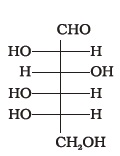
- Aldopentoses named as ribose and 2-deoxyribose are found in nucleic acids. What is their relative configuration?
- Which sugar is called invert sugar? Why is it called so?
- Amino acids can be classified as α-, β-, γ-, δ- and so on depending upon the relative position of amino group with respect to carboxyl group. Which type of amino acids form polypeptide chain in proteins?
- α-Helix is a secondary structure of proteins formed by twisting of polypeptide chain into right handed screw like structures. Which type of interactions are responsible for making the α-helix structure stable?
- Some enzymes are named after the reaction, where they are used. What name is given to the class of enzymes which catalyse the oxidation of one substrate with simultaneous reduction of another substrate.
- During curdling of milk, what happens to sugar present in it?
- How do you explain the presence of five —OH groups in glucose molecule?
- Why does compound (A) given below not form an oxime?

- Why must vitamin C be supplied regularly in diet?
- Sucrose is dextrorotatory but the mixture obtained after hydrolysis is laevorotatory. Explain.
- Amino acids behave like salts rather than simple amines or carboxylic acids. Explain.
- Structures of glycine and alanine are given below. Show the peptide linkage in glycylalanine.

- Protein found in a biological system with a unique three-dimensional structure and biological activity is called a native protein. When a protein in its native form, is subjected to a physical change like change in temperature or a chemical change like, change in pH, denaturation of protein takes place. Explain the cause.
- Activation energy for the acid catalysed hydrolysis of sucrose is 6.22 kJ mol–1, while the activation energy is only 2.15 kJ mol–1 when hydrolysis is catalysed by the enzyme sucrase. Explain.
- How do you explain the presence of an aldehydic group in a glucose molecule?
- Which moieties of nucleosides are involved in the formation of phosphodiester linkages present in dinucleotides? What does the word diester in the name of linkage indicate? Which acid is involved in the formation of this linkage?
- What are glycosidic linkages? In which type of biomolecules are they present?
- Which monosaccharide units are present in starch, cellulose and glucose and which linkages link these units?
- How do enzymes help a substrate to be attacked by the reagent effectively?
- Describe the term D- and L- configuration used for amino acids with examples.
- How will you distinguish 1° and 2° hydroxyl groups present in glucose? Explain with reactions.
- Coagulation of egg white on boiling is an example of denaturation of protein. Explain it in terms of structural changes.
Matching Type Questions
Note : Match the items of Column I and Column II in the following questions. More than one option in Column II may match with the items given in Column I.
- Match the vitamins given in Column I with the deficiency disease they cause given in Column II.
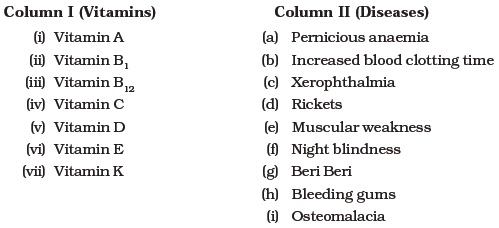
- Match the following enzymes given in Column I with the reactions they catalyse given in Column II.

Assertion and Reason Type Questions
Note : In the following questions a statement of assertion followed by a statement of reason is given. Choose the correct answer out of the following choices.
(i) Assertion and reason both are correct statements and reason explains the assertion.
(ii) Both assertion and reason are wrong statements.
(iii) Assertion is correct statement and reason is wrong statement.
(iv) Assertion is wrong statement and reason is correct statement.
(v) Assertion and reason both are correct statements but reason does not explain assertion.
- Assertion : D (+) – Glucose is dextrorotatory in nature.
Reason : ‘D’ represents its dextrorotatory nature. - Assertion : Vitamin D can be stored in our body.
Reason : Vitamin D is fat soluble vitamin. - Assertion : β-glycosidic linkage is present in maltose,
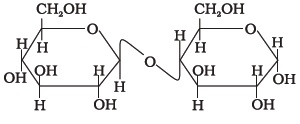
Reason : Maltose is composed of two glucose units in which C–1 of one glucose unit is linked to C–4 of another glucose unit. - Assertion : All naturally occurring α-amino acids except glycine are optically active.
Reason : Most naturally occurring amino acids have L-configuration. - Assertion : Deoxyribose, C5H10O5 is not a carbohydrate.
Reason : Carbohydrates are hydrates of carbon so compounds which follow Cx(H2O)y formula are carbohydrates. - Assertion : Glycine must be taken through diet.
Reason : It is an essential amino acid. - Assertion : In presence of enzyme, substrate molecule can be attacked by the reagent effectively.
Reason : Active sites of enzymes hold the substrate molecule in a suitable position
Long Answer Type Questions
- Write the reactions of D-glucose which can’t be explained by its open-chain structure. How can cyclic structure of glucose explain these reactions?
- On the basis of which evidences D-glucose was assigned the following structure?

- Carbohydrates are essential for life in both plants and animals. Name the carbohydrates that are used as storage molecules in plants and animals, also name the carbohydrate which is present in wood or in the fibre of cotton cloth.
- Explain the terms primary and secondary structure of proteins. What is the difference between α-helix and β-pleated sheet structure of proteins?
- Write the structures of fragments produced on complete hydrolysis of DNA. How are they linked in DNA molecule? Draw a diagram to show pairing of nucleotide bases in double helix of DNA.
| « Previous | Next » |
Answers






Chemistry Physics Maths Biology
To get study material, exam alerts and news, join our Whatsapp Channel.


